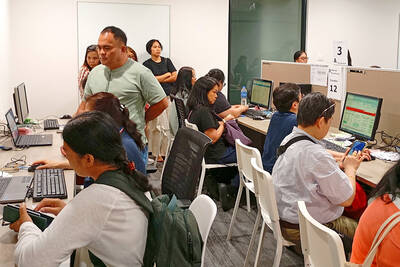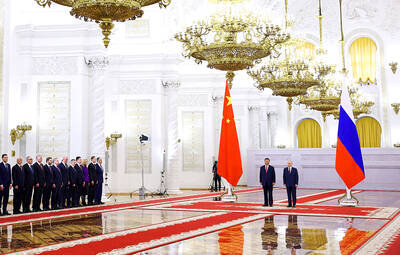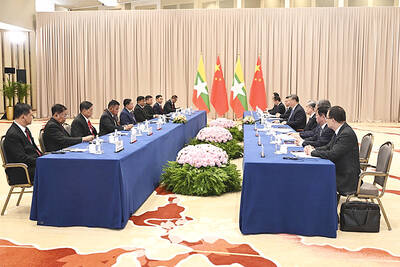American military scientists are developing a weapon which kills high-energy gamma rays, it was claimed yesterday.
The bomb, which produces little fallout, blurs the distinction between conventional and nuclear weapons, and experts have already warned it could spark a new arms race. The science behind the gamma-ray bomb is still in its infancy, and technical problems mean it could be decades before the devices are developed. But the Pentagon is taking the project seriously.
The plans are getting under way at a time when the George W. Bush administration is seeking ways to expand its arsenal of unconventional weapons, and could well fuel charges that Washington risks triggering a new arms race.
In May, Congress approved further research on a new generation of tactical nuclear weapons: bunker busters, designed to drill into underground shelters, buried beneath hundreds of feet of concrete, and so-called mini-nukes with explosive yields of less than five kilotonnes.
Critics say such research projects risk igniting a new arms race. They also charge the administration with seeking to put in place the conditions to end a ban on nuclear testing.
According to New Scientist magazine, the gamma-ray bombs are already included in the US department of defense's militarily critical technologies list -- a wish list of possible weapons technology that America considers essential to maintaining its superior firepower.
They would not have the destructive power of nuclear weapons, but the energy emitted from a gamma-ray bomb would be thousands of times greater than from conventional chemical explosives.
"Such extraordinary energy density has the potential to revolutionize all aspects of warfare," the magazine quotes the defense department list as saying.
The device would not produce energy by triggering a nuclear fission or fusion reaction. Instead it would rely on the gamma rays produced when the high-energy nuclei of some radioactive elements decay.
Such weapons would allow military commanders to increase firepower without being forced to push the nuclear button. Experts have warned that if the US succeeds in building a gamma-ray bomb, it could force other countries to start nuclear programs or encourage those who already possess nuclear weapons to use them.

A new online voting system aimed at boosting turnout among the Philippines’ millions of overseas workers ahead of Monday’s mid-term elections has been marked by confusion and fears of disenfranchisement. Thousands of overseas Filipino workers have already cast their ballots in the race dominated by a bitter feud between President Ferdinand Marcos Jr and his impeached vice president, Sara Duterte. While official turnout figures are not yet publicly available, data from the Philippine Commission on Elections (COMELEC) showed that at least 134,000 of the 1.22 million registered overseas voters have signed up for the new online system, which opened on April 13. However,

EUROPEAN FUTURE? Albanian Prime Minister Edi Rama says only he could secure EU membership, but challenges remain in dealing with corruption and a brain drain Albanian Prime Minister Edi Rama seeks to win an unprecedented fourth term, pledging to finally take the country into the EU and turn it into a hot tourist destination with some help from the Trump family. The artist-turned-politician has been pitching Albania as a trendy coastal destination, which has helped to drive up tourism arrivals to a record 11 million last year. US President Donald Trump’s son-in-law, Jared Kushner, also joined in the rush, pledging to invest US$1.4 billion to turn a largely deserted island into a luxurious getaway. Rama is expected to win another term after yesterday’s vote. The vote would

ALLIES: Calling Putin his ‘old friend,’ Xi said Beijing stood alongside Russia ‘in the face of the international counter-current of unilateralism and hegemonic bullying’ Chinese President Xi Jinping (習近平) yesterday was in Moscow for a state visit ahead of the Kremlin’s grand Victory Day celebrations, as Ukraine accused Russia’s army of launching air strikes just hours into a supposed truce. More than 20 foreign leaders were in Russia to attend a vast military parade today marking 80 years since the defeat of Nazi Germany in World War II, taking place three years into Russia’s offensive in Ukraine. Putin ordered troops into Ukraine in February 2022 and has marshaled the memory of Soviet victory against Nazi Germany to justify his campaign and rally society behind the offensive,

Myanmar’s junta chief met Chinese President Xi Jinping (習近平) for the first time since seizing power, state media reported yesterday, the highest-level meeting with a key ally for the internationally sanctioned military leader. Senior General Min Aung Hlaing led a military coup in 2021, overthrowing Myanmar’s brief experiment with democracy and plunging the nation into civil war. In the four years since, his armed forces have battled dozens of ethnic armed groups and rebel militias — some with close links to China — opposed to its rule. The conflict has seen Min Aung Hlaing draw condemnation from rights groups and pursued by the